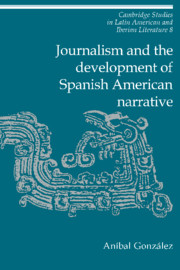Book contents
- Frontmatter
- Contents
- Acknowledgments
- 1 Journalism, modernity, and narrative fiction in Spanish America
- 2 Journalism and (dis)simulation in El Periquillo Sarniento
- 3 Sarmiento and sensationalist journalism: Facundo as crime story
- 4 Journalism versus genealogy: Ricardo Palma's Tradiciones peruanas
- 5 Journalism and the self: the Modernist chronicles
- 6 Journalism and the ethics of writing: Borges, García Márquez, Vargas Llosa, Poniatowska
- Notes
- Bibliography of works cited
- Index
3 - Sarmiento and sensationalist journalism: Facundo as crime story
Published online by Cambridge University Press: 08 October 2009
- Frontmatter
- Contents
- Acknowledgments
- 1 Journalism, modernity, and narrative fiction in Spanish America
- 2 Journalism and (dis)simulation in El Periquillo Sarniento
- 3 Sarmiento and sensationalist journalism: Facundo as crime story
- 4 Journalism versus genealogy: Ricardo Palma's Tradiciones peruanas
- 5 Journalism and the self: the Modernist chronicles
- 6 Journalism and the ethics of writing: Borges, García Márquez, Vargas Llosa, Poniatowska
- Notes
- Bibliography of works cited
- Index
Summary
If the reader is bored by these arguments, I will recount to him dreadful crimes.
Domingo F. Sarmiento, Facundo (1845)And the novel? May we not pose the question of the novel – whose literary hegemony is achieved precisely in the nineteenth century – in the context of the age of discipline?
D. A. Miller, The Novel and the Police (1988)It is already a hoary critical cliche to speak of Domingo Faustino Sarmiento's classic work, Facundo, o Civilización y barbarie (1845), as an unclassifiable, multifaceted, ageneric text. Critics have remarked for decades on the uneasy coexistence of heterogenous discourses in Sarmiento's text, such as those of natural and national history, politics, sociology, and narrative fiction. Carlos J. Alonso sagaciously observes that the very presence of the conjunction “y” (“and”) in the work's subtitle (Civilización y barbarie) is an indication of the totalizing, amalgamating nature of this text, which tries forcibly to bring together seemingly disparate and incompatible concepts (“Civilización y barbarie,” p. 257). But above and beyond its inner discursive diversity, Facundo achieves a certain unity as a complicated rhetorical performance designed to persuade its readers both of the evils of Juan Manuel de Rosas and of the possibility that the same Argentine reality that gave rise to the dictator may also produce his antithesis.
- Type
- Chapter
- Information
- Publisher: Cambridge University PressPrint publication year: 1993



